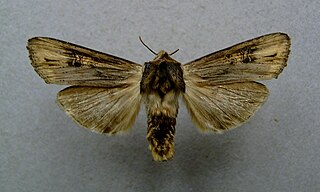Related Research Articles

Zamia roezlii is a species of cycad, a plant in the family Zamiaceae. It is found in Colombia and the Pacific coast of Ecuador. It is named for the Czech botanist Benedikt Roezl. A single sperm cell from Zamia roezlii is about 0.4 mm in length and is visible to the unaided eye, being the world's largest plant sperm cell. Drosophila bifurca, a species of fruit fly, has sperm that are 5.8 cm long, albeit mostly coiled tail.

Xylena exsoleta, the sword-grass, is a species of moth of the family Noctuidae.
Bifurca is a monotypic moth genus in the subfamily Lymantriinae. Its only species, Bifurca longinasus, is found in Vietnam. Both the genus and the species were first described by Joseph de Joannis in 1929.
Pherotesia is a genus of moths in the family Geometridae. The genus was described by Schaus in 1901.
Crassispira bifurca is a species of sea snail, a marine gastropod mollusk in the family Pseudomelatomidae.

The Erebidae are a family of moths in the superfamily Noctuoidea. The family is among the largest families of moths by species count and contains a wide variety of well-known macromoth groups. The family includes the underwings (Catocala); litter moths (Herminiinae); tiger, lichen, and wasp moths (Arctiinae); tussock moths (Lymantriinae), including the arctic woolly bear moth ; piercing moths ; micronoctuoid moths (Micronoctuini); snout moths (Hypeninae); and zales, though many of these common names can also refer to moths outside the Erebidae. Some of the erebid moths are called owlets.
Neomicropteryx cornuta is a species of moth belonging to the family Micropterigidae. It was described by Syuti Issiki in 1953. It is known from Japan.
Neomicropteryx elongata is a species of moth belonging to the family Micropterigidae. It was described by Syuti Issiki in 1953. It is known from Japan.
Neomicropteryx kazusana is a species of moth belonging to the family Micropterigidae. It was described by Hashimoto in 1992. It is known from Japan (Honshu).
Neomicropteryx matsumurana is a species of moth belonging to the family Micropterigidae. It was described by Syuti Issiki in 1931. It is known from Japan.
Neomicropteryx nipponensis is a species of moth belonging to the family Micropterigidae. It was described by Syuti Issiki in 1931. It is known from Japan.
Issikiomartyria nudata is a species of moth belonging to the family Micropterigidae. It was described by Syuti Issiki in 1953. It is known from Japan.
Neomicropteryx kiwana is a species of moth belonging to the family Micropterigidae. It was described by Hashimoto in 2006 and is known from Japan.
Neomicropteryx redacta is a species of moth belonging to the family Micropterigidae. It was described by Hashimoto in 2006 and is known from Japan.
Afraloa is a monotypic tiger moth genus in the family Erebidae erected by Vladimir Viktorovitch Dubatolov in 2006. Its only species, Afraloa bifurca, was first described by Francis Walker in 1855. It is found in Cameroon, the Democratic Republic of the Congo, Equatorial Guinea, Gabon, Ghana, Kenya, Nigeria, Sierra Leone, the Gambia, Togo, Uganda and Pakistan.

Lithophane furcifera, the conformist, is a moth of the family Noctuidae. The species was first described by Johann Siegfried Hufnagel in 1766. It is found from central Europe, east to the Black Sea region, the Caucasus and western Siberia. In the mountains, it is found up to elevations of 1,800 meters.

Oregonia bifurca, commonly known as the split-nose crab or the split-nose decorator crab, is a species of crabs belonging to the genus Oregonia. It is a rare deep-water species that inhabits the tops of seamounts and guyots in the northeastern Pacific Ocean; from the Aleutian Islands, the Bering Sea, the Hawaiian–Emperor seamount chain, to the waters off British Columbia. It is closely related to the more common shallow-water species Oregonia gracilis, the graceful decorator crab.

Eucosma cana, the hoary bell, is a species of moth of the family Tortricidae.
Dichomeris bifurca is a moth in the family Gelechiidae. It was described by Hou-Hun Li and Zhe-Min Zheng in 1996. It is found in the Chinese provinces of Sichuan, Jiangxi and Fujian.
References
- ↑ Beccaloni, G.; Scoble, M.; Kitching, I.; Simonsen, T.; Robinson, G.; Pitkin, B.; Hine, A.; Lyal, C., eds. (2003). "Neomicropteryx bifurca". The Global Lepidoptera Names Index . Natural History Museum . Retrieved May 11, 2018.
- ↑ Japanese Moths
| This article on a moth of the family Micropterigidae is a stub. You can help Wikipedia by expanding it. |